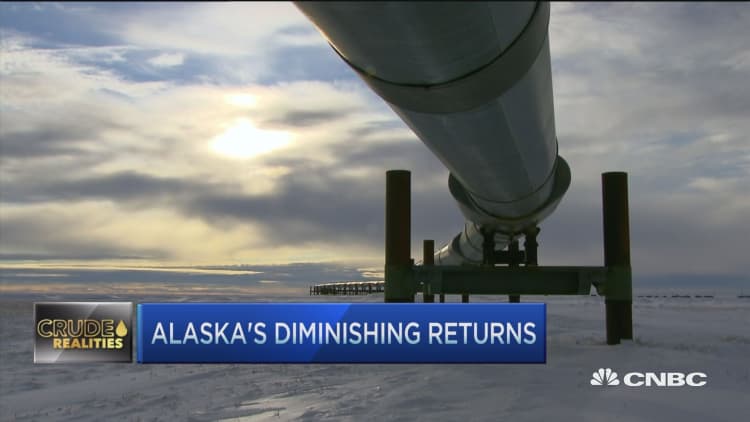


For the past 50 years, the oilfields of Alaska's North Slope have been dominated by BP, Exxon Mobil and ConocoPhillips. The big three produce much of the state's oil and gas, but independent drillers are now trying to pioneer the Last Frontier's energy future.
Independent exploration and production companies have historically been willing to take on the country's riskier oil plays, operating with skinny profit margins and applying new technology to try for potentially huge payoffs. In Alaska, recent discoveries could hold the key to stemming a nearly three-decade decline in the state's oil output.
The finds could rank among the largest new onshore assets in the United States, said former Alaska Natural Resources Commissioner Mark Myers. Among them are fields that have sat beneath the noses of big oil firms near the prolific Prudhoe Bay and Kuparuk fields, Myers told CNBC shortly before he retired this year.
"The bottom line is there is still a lot of oil up there, a huge amount," he said.
Whether drillers can make a dent in the long-running decline is a question of enormous gravity for a state that has derived as much as 90 percent of revenue from the oil and gas industry. The task has only become more pressing now that a 60-percent collapse in crude prices has plunged Alaska into a budget crisis.
To be sure, the challenge of turning the tide is massive. Alaska's annual oil production peaked in 1988 at about 760 million barrels. Last year, it stood at 192 million barrels. The Trans-Alaska Pipeline, which transports crude from Prudhoe Bay and other North Slope fields to the southern shores of Valdez, now operates at roughly one-quarter capacity.
One-third of the nation's reserves are in Alaska, on shore and offshore combined. The challenge for us is not a lack of resource.Kara Moriartypresident, Alaska Oil and Gas Association
The state's proven oil reserves stand at under 3 billion barrels today, down from more than 7 billion barrels 30 years ago, according to Energy Information Administration data.
But the Alaska Oil and Gas Association believes there are still 5 billion to 6 billion barrels of reserves in existing oilfields, yet more offshore, and another 25 to 30 billion barrels of heavy crude that cannot yet be accessed with today's technology, association President Kara Moriarty told CNBC.
"All told, all of that combined, one-third of the nation's reserves are in Alaska, on shore and offshore combined," she told CNBC. "The challenge for us is not a lack of resource."
The challenges, she said, are Alaska's distance from markets, high production and labor costs, and infrastructure challenges, all of which put the average pre-tax cost to produce a barrel of Alaskan oil at $52.
The protracted crude price downturn has made the prospect of exploring less attractive. At the same time, Gov. Bill Walker and state lawmakers have proposed slashing energy industry incentives in order to cover a $4.1 billion state budget gap.
Alaska is projected to spend $500 million on oil tax credits in fiscal year 2016, making the incentives the state's third largest expenditure after education and health and social services, according to Gunnar Knapp, professor of economics at the University of Alaska Anchorage.
New discoveries in the Last Frontier
With Alaska's easy oil tapped long ago, the stage was set for wildcatters to take the baton from big oil. In the mid-2000s, surging oil prices and tax credits designed to stimulate new production provided the spark.
Colorado-based Armstrong Oil and Gas is exploring in the Colville River Delta, between the Kuparuk and Alpine field, the last major discovery in Alaska. A third-party assessment of the area determined they held about 500 million barrels of proven reserves, and 1.4 billion in probable reserves.
"I think it has the potential to be the single largest oilfield in North America," said Myers, though he cautioned he couldn't say so with certainty.
Despite stubbornly low oil prices, Armstrong president Bill Armstrong told Petroleum News in February that the company would accelerate development in its North Slope Pikka unit, along with minority partner Repsol of Spain.
Another company chasing Alaska's next oil giant is Caelus Energy, an independent formed in 2013 to develop large-scale projects. The firm is backed by Apollo Global Management and led by James Musselman, the oilman who helmed Kosmos Energy when it discovered the Jubilee oil field, one of the biggest discoveries in offshore West Africa.
Caelus operates the Oooguruk Development Project in the Beaufort Sea, and was until recently ramping up its nearby onshore Nuna field, each of which the company estimates to hold up to 150 million barrels. The crown jewel, though, is the company's Smith Bay Exploration Project, which Caelus believes could yield a billion barrels of oil.
Low crude prices have bit into Caelus' plans, however. Earlier this month, Caelus said it would lay off 25 percent of its staff and cease drilling at Oooguruk, which supports about 300 contractors, and put the Nuna project on hold, Petroleum News reported.
In testimony before the state senate resources committee, Caelus Vice President Pat Foley said low oil prices would have forced the action even if tax credits remained unchanged, but Caelus may need to see oil prices go higher before it begins drilling again, should lawmakers push through the reform, Alaska Public Media reported.
To make major Alaskan projects work, drillers need oil to return to $60 to $70 a barrel, Myers said. Given a five- to seven-year time frame to bring them online, it's possible prices will support the production by the time they're ready to begin pumping.






